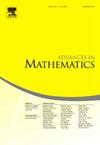A unified approach to mass transference principle and large intersection property
IF 1.5
1区 数学
Q1 MATHEMATICS
引用次数: 0
Abstract
The mass transference principle, discovered by Beresnevich and Velani (2006) [5], is a landmark result in metric Diophantine approximation that allows us to obtain the Hausdorff measure theory of sets. Another important tool is the notion of a large intersection property, introduced and systematically studied by Falconer (1994) [9]. The former mainly focuses on passing between full (Lebesgue) measure and full Hausdorff measure statements, while the latter transfers full Hausdorff content statement to Hausdorff dimension. From this perspective, the proofs of the two results are similar but often treated in different ways.
In this paper, we establish a general mass transference principle from the viewpoint of Hausdorff content, aiming to provide a unified proof for the aforementioned results. More precisely, this principle enables us to transfer the Hausdorff content bounds of a sequence of open sets to the full Hausdorff measure statement and the large intersection property for . One of the advantages of our approach is that the verification of the Hausdorff content bound does not require the construction of Cantor-like subset, resulting in a much simpler proof. As an application, we provide simpler proofs for several mass transference principles.
对传质原理和大相交特性的统一研究
Beresnevich和Velani(2006)[5]发现的传质原理是度量丢芬图近似的一个里程碑式的结果,它使我们得以获得limsup集合的Hausdorff测度理论。另一个重要的工具是由Falconer(1994)引入并系统研究的大交集属性的概念。前者主要侧重于在全(勒贝格)测度和全豪斯多夫测度语句之间传递,后者则将全豪斯多夫内容语句传递到豪斯多夫维度。从这个角度来看,这两个结果的证明是相似的,但往往以不同的方式处理。本文从豪斯多夫内容的角度出发,建立了一个一般的传质原理,旨在为上述结果提供一个统一的证明。更准确地说,这一原理使我们能够将开集序列En的Hausdorff内容界转化为完整的Hausdorff测度陈述和limsupEn的大相交性质。我们的方法的优点之一是Hausdorff内容界的验证不需要构造类cantor子集,从而使证明更加简单。作为应用,我们为几个传质原理提供了更简单的证明。
本文章由计算机程序翻译,如有差异,请以英文原文为准。
求助全文
约1分钟内获得全文
求助全文
来源期刊

Advances in Mathematics
数学-数学
CiteScore
2.80
自引率
5.90%
发文量
497
审稿时长
7.5 months
期刊介绍:
Emphasizing contributions that represent significant advances in all areas of pure mathematics, Advances in Mathematics provides research mathematicians with an effective medium for communicating important recent developments in their areas of specialization to colleagues and to scientists in related disciplines.
 求助内容:
求助内容: 应助结果提醒方式:
应助结果提醒方式:


